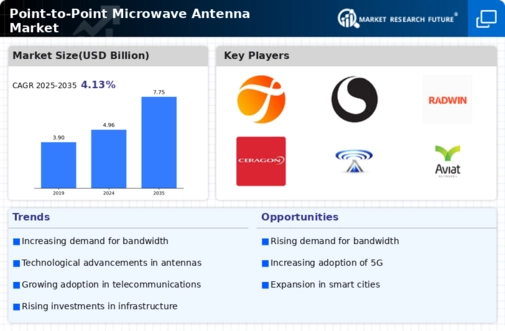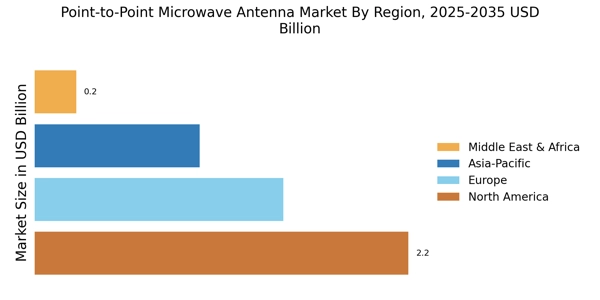Focus on Cost Efficiency
Cost efficiency remains a significant driver in the Point-to-Point Microwave Antenna Market. As businesses seek to optimize their operational expenditures, the demand for cost-effective communication solutions has intensified. Microwave antennas offer a lower total cost of ownership compared to traditional fiber optic solutions, particularly in challenging terrains where installation costs can be prohibitive. The ability to deploy these antennas quickly and with minimal infrastructure makes them an attractive option for many organizations. Market analysis indicates that the cost savings associated with microwave technology can be as high as 30% compared to other communication methods, thereby encouraging wider adoption across various sectors.
Growing Demand for High-Speed Connectivity
The demand for high-speed connectivity is a primary driver of the Point-to-Point Microwave Antenna Market. With the proliferation of data-intensive applications, such as streaming services and cloud computing, there is an increasing need for robust communication infrastructure. Point-to-Point microwave antennas provide a reliable solution for delivering high-speed internet access, particularly in remote and underserved areas. According to recent estimates, the market for high-speed data transmission is expected to reach USD 10 billion by 2026, highlighting the critical role of microwave antennas in meeting this demand. This trend is further fueled by the expansion of 5G networks, which require advanced antenna systems to support their high bandwidth requirements.
Technological Advancements in Communication
The Point-to-Point Microwave Antenna Market is experiencing a surge in technological advancements that enhance communication capabilities. Innovations in antenna design, such as phased array technology, are enabling higher data transmission rates and improved signal quality. These advancements are crucial as they allow for more efficient use of the available spectrum, which is increasingly important in densely populated areas. The integration of advanced materials and manufacturing techniques is also contributing to the development of lighter and more durable antennas. As a result, the market is projected to grow at a compound annual growth rate of approximately 8% over the next five years, driven by the need for reliable and high-performance communication solutions.
Rising Adoption of Wireless Communication Technologies
The rising adoption of wireless communication technologies is significantly influencing the Point-to-Point Microwave Antenna Market. As organizations transition towards wireless solutions for their communication needs, the demand for microwave antennas is expected to increase. These antennas facilitate high-capacity data transmission without the need for extensive cabling, making them ideal for urban environments where space is limited. The trend towards wireless technologies is further supported by the growing Internet of Things (IoT) ecosystem, which requires efficient data transfer between devices. Market forecasts suggest that the adoption of wireless communication technologies could drive a 20% increase in the demand for point-to-point microwave antennas over the next few years.
Increased Investment in Telecommunications Infrastructure
Investment in telecommunications infrastructure is a crucial driver for the Point-to-Point Microwave Antenna Market. Governments and private entities are increasingly recognizing the importance of robust communication networks to support economic growth and social development. This has led to substantial funding for the expansion of telecommunications infrastructure, particularly in developing regions. The market is expected to benefit from initiatives aimed at enhancing connectivity, with investments projected to exceed USD 15 billion by 2027. Such investments are likely to create opportunities for the deployment of microwave antennas, which are essential for establishing reliable point-to-point communication links.


















Leave a Comment